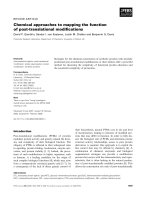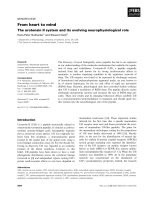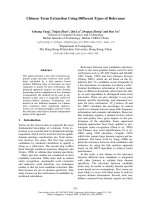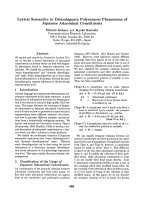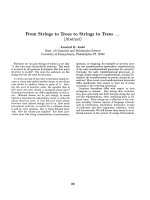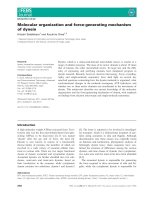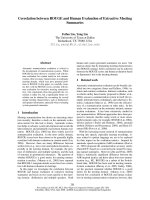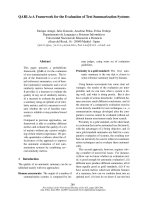Báo cáo khoa học: "FROM N-GRAMS TO COLLOCATIONS AN EVALUATION OF XTRACT" pot
Bạn đang xem bản rút gọn của tài liệu. Xem và tải ngay bản đầy đủ của tài liệu tại đây (484.82 KB, 6 trang )
FROM N-GRAMS TO COLLOCATIONS
AN EVALUATION OF XTRACT
Frank A. Smadja
Department of Computer Science
Columbia University
New York, NY 10027
Abstract
In previous papers we presented methods for
retrieving collocations from large samples of
texts. We described a tool, Xtract, that im-
plements these methods and able to retrieve
a wide range of collocations in a two stage
process. These methods a.s well as other re-
lated methods however have some limitations.
Mainly, the produced collocations do not in-
clude any kind of functional information and
many of them are invalid. In this paper we
introduce methods that address these issues.
These methods are implemented in an added
third stage to Xtract that examines the set of
collocations retrieved during the previous two
stages to both filter out a number of invalid col-
locations and add useful syntactic information
to the retained ones. By combining parsing and
statistical techniques the addition of this third
stage has raised the overall precision level of
Xtract from 40% to 80% With a precision of
94%. In the paper we describe the methods
and the evaluation experiments.
1
INTRODUCTION
In the past, several approaches have been proposed to
retrieve various types of collocations from the analysis
of large samples of textual data. Pairwise associations
(bigrams or 2-grams)
(e.g.,
[Smadja, 1988], [Church and
Hanks, 1989]) as well as n-word (n > 2) associations
(or n-grams)
(e.g.,
[Choueka
el al.,
1983], [Smadja and
McKeown, 1990]) were retrieved. These techniques auto-
matically produced large numbers of collocations along
with statistical figures intended to reflect their relevance.
However, none of these techniques provides functional in-
formation along with the collocation. Also, the results
produced often contained improper word associations re-
flecting some spurious aspect of the training corpus that
did not stand for true collocations. This paper addresses
these two problems.
Previous papers
(e.g.,
[Smadja and McKeown,
1990]) introduced a. set of tecl)niques and a. tool, Xtract,
that produces various types of collocations from a two-
stage statistical analysis of large textual corpora briefly
sketched in the next section. In Sections 3 and 4, we
show how robust parsing technology can be used to both
filter out a number of invalid collocations as well as add
useful syntactic information to the retained ones. This
filter/analyzer is implemented in a third stage of Xtract
that automatically goes over a the output collocations to
reject the invalid ones and label the valid ones with syn-
tactic information. For example, if the first two stages
of Xtract produce the collocation
"make-decision,"
the
goal of this third stage'is to identify it as a verb-object
collocation. If no such syntactic relation is observed,
then the collocation is rejected. In Section 5 we present
an evaluation of Xtract as a collocation retrieval sys-
tem. The addition of the third stage of Xtract has been
evaluated to raise the precision of Xtract from 40% to
80°£ and it has a recall of 94%. In this paper we use ex-
amples related to the word
"takeover"
from a 10 million
word corpus containing stock market reports originating
from the Associated Press newswire.
2 FIRST 2 STAGES OF XTRACT,
PRODUCING N-GRAMS
In afirst stage, Xtract uses statistical techniques to
retrieve pairs of words (or bigrams) whose common ap-
pearances within a single sentence are correlated in the
corpus. A bigram is retrieved if its frequency of occur-
rence is above a certain threshold and if the words are
used in relatively rigid ways. Some bigrams produced
by the first stage of Xtract are given in Table 1: the
bigrams all contain the word
"takeover"
and an adjec-
tive. In the table, the
distance
parameter indicates the
usual distance between the two words. For example,
distance
= 1 indicates that the two words are fre-
quently adjacent in the corpus.
In a second stage, Xtract uses the output bi-
grams to produce collocations involving more than two
words (or n-grams). It examines all the sentences con-
taining the bigram and analyzes the statistical distri-
bution of words and parts of speech for each position
around the pair. It retains words (or parts of speech) oc-
cupying a position with probability greater than a given
279
threshold. For example, the bigram "average-industrial"
produces the n-gram
"the Dow Jones industrial average"
since the words are always used within this compound
in the training corpus. Example. outputs of the second
stage of Xtraet are given in Figure 1. In the figure, the
numbers on the left indicate the frequency of the n-grams
in the corpus, NN indicates that. a noun is expected at
this position, AT indicates that an article is expected,
NP stands for a proper noun and VBD stands for a verb
in the past tense. See [Smadja and McKeown, 1990] and
[Smadja, 1991] for more details on these two stages.
Table 1: Output of Stage 1
Wi
hostile
hostile
corporate
hostile
unwanted
potential
unsolicited
unsuccessful
friendly
takeover
takeover
big
wj
takeovers
takeover
takeovers
takeovers
takeover
takeover
takeover
takeover
takeover
expensive
big
takeover
distance
1
1
1
2
1
1
1
1
1
2
4
1
3 STAGE THREE: SYNTACTICALLY
LABELING COLLOCATIONS
In the past, Debili [Debili, 1982] parsed corpora of French
texts to identify non-ambiguous predicate argument rela-
tions. He then used these relations for disambiguation in
parsing. Since then, the advent of robust parsers such as
Cass [Abney, 1990], Fidditeh [Itindle, 1983] has made it
possible to process large amounts of text with good per-
formance. This enabled Itindle and Rooth [Hindle and
Rooth, 1990], to improve Debili's work by using bigram
statistics to enhance the task of prepositional phrase at-
tachment. Combining statistical and parsing methods
has also been done by Church and his colleagues. In
[Church
et al.,
1989] and [Church'et
ai.,
1991] they con-
sider predicate argument relations in the form of ques-
tions such as
What does a boat typically do?
They are
preprocessing a corpus with the Fiddlteh parser in order
to statistically analyze the distribution of the predicates
used with a given argument such as
"boat."
Our goal is different, since we analyze a set of
collocations automatically produced by Xtract to either
enrich them with syntactic information or reject them.
For example, if, bigram collocation produced by Xtract
involves a noun and a verb, the role of Stage 3 of Xtract
is to determine whether it is a
subject-verb
or a
verb-
object
collocation. If no such relation can be identified,
then the collocation is rejected. This section presents
the algorithm for Xtract Stage 3 in some detail. For
illustrative purposes we use the example words
takeover
and
thwart
with a distance of 2.
3.1 DESCRIPTION OF THE ALGORITHM
Input: A bigram with some distance information in-
dicating the most probable distance between the two
words. For example,
takeover and thwart
with a distance
of 2.
Output/Goah Either a syntactic label for the bigram
or a rejection. In the case of
takeover
and
thwart
the
collocation is accepted and its produced label is
VO
for
verb-object.
The algorithm works in the following 3
steps:
3.1.1 Step 1:
PRODUCE TAGGED
CONCORDANCES
All the sentences in the corpus that contain
the
two words in this given position are produced. This
is done with a concord,acing program which is part of
Xtraet (see [Smadja, 1991]). The sentences are labeled
with part of speech information by preprocessing the cor-
pus with an automatic stochastic tagger. 1
3.1.2 Step 2: PARSE THE SENTENCES
Each sentence is then processed by Cass, a
bottom-up incremental parser [Abney, 1990]. 2
Cass
takes input sentences labeled with part of speech and
attempts to identify syntactic structure. One of Cass
modules identifies predicate argument relations. We use
this module to produce binary syntactic relations (or la-
bels) such as
"verb-object" (VO), %erb-subject" (VS),
"noun-adjective" (N J),
and
"noun-noun" ( N N ).
Con-
sider Sentence (1) below and all the labels as produced
by Cass on it.
(1)
"Under the recapitalization plan it proposed to
thwart
the
takeover."
label bigrarn
SV
it proposed
NN
recapitalization plan
VO
thwart takeover
For each sentence in the concordance set, from
the output of Cass, Xtract determines the syntactic
relation of the two words among
VO, SV, N J, NN
and
assigns this label to the sentence. If no such relation is
observed, Xtract associates the label U (for undefined)
to the sentence. We note
label[ia~
the label associated
1For this, we use the part of speech tagger described in
[Church, 1988]. This program was developed at Bell Labora-
tories by Ken Church.
UThe parser has been developed at Bell Communication
Research by Steve Abney, Cass stands for Cascaded Analysis
of Syntactic Structure. I am much grateful to Steve Abney
to help us use and customize Cass for this work.
280
681 takeover bid
310 takeover offer
258 takeover attempt
177 takeover battle
154 NN NN takeover defense
153 takeover target
119 a possible takeover NN
118 takeover law
109 takeover rumors
102 takeover speculation
84 takeover strategist
69 AT takeover fight .
62 corporate takeover
50 takeover proposals
40 Federated's poison pill takeover defense
33 NN VBD a sweetened takeover offer from . NP
Figure 1: Some n-grams containing
"takeover"
with Sentence
id.
For example, the label for Sentence (1)
is:
label[l] - VO.
4 A LEXICOGRAPHIC
EVALUATION
3.1.3 Step 3: REJECT OR LABEL
COLLOCATION
This last step consists of deciding on a label for
the bigram from the set of
label[i~'.s.
For this, we count
the frequency of each label for the bigram and perform
a statistical analysis of this distribution. A collocation
is accepted if the two seed words are consistently used
with the same syntactic relation. More precisely, the
collocation is accepted if and only if there is a label 12 ~:
U satisfying the following inequation:
[probability(labeliid ] = £)> T I
in which T is a given threshold to be determined
by the experimenter. A collocation is thus rejected if no
valid label satisfies the inequation or if U satisfies it.
Figure 2 lists some accepted collocations in the
format produced by Xtract with their syntactic labels.
For these examples, the threshold T was set to 80%.
For each collocation, the first line is the output of the
first stage of Xtract. It is the seed bigram with the
distance between the two words. The second line is the
output of the second stage of Xtract, it is a multiple
word collocation (or n-gram). The numbers on the left
indicate the frequency of occurrence of the n-gram in
the corpus. The third line indicates the syntactic label
as determined by the third stage of Xtract. Finally,
the last lines simply list an example sentence and the
position of the collocation in the sentence.
Such collocations can then be used for vari-
ous purposes including lexicography, spelling correction,
speech recognition and language generation. Ill [Smadja
and McKeown, 1990] and [Smadja, 1991] we describe
how they are used to build a lexicon for language gener-
ation in the domain of stock market reports.
The third stage of Xtract can thus be considered as a
retrieval system which retrieves valid collocations from
a set of candidates. This section describes an evaluation
experiment of the third stage of Xtract as a retrieval
system. Evaluation of retrieval systems is usually done
with the help of two parameters:
precision
and
recall
[Salton, 1989]. Precision of a retrieval system is defined
as the ratio of retrieved valid elements divided by the
total number of retrieved elements [Salton, 1989]. It
measures the quality of the retrieved material. Recall
is defined as the ratio of retrieved valid elements divided
by the total number of valid elements. It measures the
effectiveness of the system. This section presents an eval-
uation of the retrieval performance of the third stage of
Xtract.
4.1 THE EVALUATION EXPERIMENT
Deciding whether a given word combination is a
valid or invahd collocation is actually a difficult task
that is best done by a lexicographer. Jeffery Triggs is
a lexicographer working for Oxford English Dictionary
(OED) coordinating the North American Readers pro-
gram of OED at Bell Communication Research. Jef-
fery Triggs agreed to manually go over several thousands
collocations, a
We randomly selected a subset of about 4,000
collocations that contained the information compiled by
Xtract after the first 2 stages. This data set was then
the subject of the following experiment.
We gave the 4,000 collocations to evaluate to the
lexicographer, asking him to select the ones that he
3I am grateful to Jeffery whose professionalism and kind-
ness helped me understand some of the difficulty of lexicog-
raphy. Without him this evaluation would not have been
possible.
281
takeover bid -1
681 takeover bid IN
Syntactic Label: NN
10 11
An investment partnership on Friday offered to sweeten its
takeover bid for Gencorp Inc.
takeover fight -1
69 AT takeover fight IN 69
Syntactic Label: NN
10 11
Later last year Hanson won a hostile 3.9 billion takeover fight for Imperial Group
the giant British food tobacco and brewing conglomerate and raised more than 1.4
billion pounds from the sale of Imperial s Courage brewing operation and
its leisure products businesses.
takeover thwart 2
44 to thwart AT takeover NN 44
Syntactic Label: VO
13 11
The 48.50 a share offer announced Sunday is designed to thwart a takeover bid
by GAF Corp.
takeover make 2
68 MD make a takeover NN . JJ 68
Syntactic Label: VO
14 12
Meanwhile the North Carolina Senate approved a bill Tuesday that would make a
takeover of North Carolina based companies more difficult and the House was
expected to approve the measure before the end of the week.
takeover related -1
59 takeover related 59
Syntactic Label: SV
23
Among takeover related issues Kidde jumped 2 to 66.
Figure 2: Some examples of collocations with
"takeover"
YY=J20% Y=20% N = 60 % T = 40% U = 60%
T
w. 94%
T
= 94%
U O
U
= 9,5%
Y t0%
YY
= 40%
N
92%
Figure 3: Overlap of the manual and automatic evaluations
282
would consider for a domain specific dictionary and to
cross out the others. The lexicographer came up with
three simple tags, YY, Y and N. Both Y and YY are
good collocations, and N are bad collocations. The dif-
ference between YY and Y is that Y collocations are of
better quality than YY collocations. YY collocations
are often too specific to be included in a dictionary, or
some words are missing, etc. After Stage 2, about 20%
of the collocations are Y, about 20% are YY, and about
60% are N. This told us that the precision of Xtract at
Stage 2 was only about 40 %.
Although this would seem like a poor precision,
one should compare it with the much lower rates cur-
rently in practice in lexicography. For the OED, for
example, the first stage roughly consists of reading nu-
merous documents to identify new or
interesting
expres-
sions. This task is performed by professional
readers.
For the OED, the readers for the American program
alone produce some 10,000 expressions a month. These
lists are then sent off to the dictionary and go through
several rounds of careful analysis before actually being
submitted to the dictionary. The ratio of proposed can-
didates to good candidates is usually low. For example,
out of the 10,000 expressions proposed each month, less
than 400 are serious candidate for the OED, which rep-
resents a current rate of 4%. Automatically producing
lists of candidate expressions could actually be of great
help to lexicographers and even a precision of 40% would
be helpful. Such lexicographic tools could, for example,
help readers retrieve sublanguage specific expressions by
providing them with lists of candidate collocations. The
lexicographer then manually examines the list to remove
the irrelevant data. Even low precision is useful for
lexicographers as manual filtering is much faster than
manual scanning of the documents [Marcus, 1990]. Such
techniques are not able to replace readers though, as they
are not designed to identify low frequency expressions,
whereas a human reader immediately identifies interest-
ing expressions with as few as one occurrence.
The second stage of this experiment was to use
Xtract Stage 3 to filter out and label the sample set of
collocations. As described in Section 3, there are several
valid labels
(VO, VS, NN,
etc.). In this experiment, we
grouped them under a single label: T. There is only one
non-valid label: U (for unlabeled}. A T collocation is
thus accepted by Xtract Stage 3, and a U collocation is
rejected. The results of the use of Stage 3 on the sample
set of collocations are similar to the manual evaluation
in terms of numbers: about 40% of the collocations were
labeled (T) by Xtract Stage 3, and about 60% were
rejected (U).
Figure 3 shows the overlap of the classifications
made by Xtract and the lexicographer. In the figure,
the first diagram on the left represents the breakdown in
T and U of each of the manual categories (Y - YY and
N). The diagram on the right represents the breakdown
in Y - YY and N of the the T and U categories. For
example, the first column of the diagram on the left rep-
resents the application of Xtract Stage 3 on the YY col-
locations. It shows that 94% of the collocations accepted
by the lexicographer were also accepted by Xtract. In
other words, this means that the recall ofthe third stage
of Xtract is 94%. The first column of the diagram on the
right represents the lexicographic evaluation of the collo-
cations automatically accepted by Xtract. It shows that
about 80% of the T collocations were accepted by the
lexicographer and that about 20% were rejected. This
shows that precision was raised from 40% to 80% with
the addition of Xtract Stage 3. In summary, these ex-
periments allowed us to evaluate Stage 3 as a retrieval
system. The results are:
I Precision = 80% Recall = 94% ]
5 SUMMARY AND
CONTRIBUTIONS
In this paper, we described a new set of techniques for
syntactically filtering and labeling collocations. Using
such techniques for post processing the set of colloca-
tions produced by Xtract has two major results. First,
it adds syntax to the collocations which is necessary for
computational use. Second, it provides considerable im-
provement to the quality of the retrieved collocations as
the precision of Xtract is raised from 40% to 80% with
a recall of 94%.
By combining statistical techniques with a sophis-
ticated robust parser we have been able to design and
implement some original techniques for the automatic
extraction of collocations. Results so far are very en-
couraging and they indicate that more efforts should be
made at combining statistical techniques with more sym-
bolic ones.
ACKNOWLEDGMENTS
The research reported in this paper was partially sup-
ported by DARPA grant N00039-84-C-0165, by NSF
grant IRT-84-51438 and by ONR grant N00014-89-J-
1782. Most of this work is also done in collaboration with
Bell Communication Research, 445 South Street, Mor-
ristown, N3 07960-1910. I wish to express my thanks
to Kathy McKeown for her comments on the research
presented in this paper. I also wish to thank Dor~e
Seligmann and Michael Elhadad for the time they spent
discussing this paper and other topics with me.
References
[Abney, 1990] S. Abney. Rapid Incremental Parsing
with Repair. In
Waterloo Conference on Electronic
Text Research,
1990.
[Choueka el
al.,
1983] Y. Choueka, T. Klein, and
E. Neuwitz. Automatic Retrieval of Frequent Id-
iomatic and Collocational Expressions in a Large Cot-
283
pus. Journal for Literary and Linguistic computing,
4:34-38, 1983.
[Church and Hanks, 1989] K. Church and K. Hanks.
Word Association Norms, Mutual Information, and
Lexicography. In Proceedings of the 27th meeting of
the A CL, pages 76-83. Association for Computational
Linguistics, 1989. Also in Computational Linguistics,
vol. 16.1, March 1990.
[Church et at., 1989] K.W. Church, W. Gale, P. Hanks,
and D. Hindle. Parsing, Word Associations and Typ-
ical Predicate-Argument Relations. In Proceedings of
the International Workshop on Parsing Technologies,
pages 103-112, Carnegie Mellon University, Pitts-
burgh, PA, 1989. Also appears in Masaru Tomita
(ed.), Current Issues in Parsing Technology, pp. 103-
112, Kluwer Academic Publishers, Boston, MA, 1991.
[Church et
at.,
1991] K.W. Church, W. Gale, P. Hanks,
and D. Hindle. Using Statistics in Lexical Analysis. In
Uri ~ernik, editor, Lexical Acquisition: Using on-line
resources to build a lexicon. Lawrence Erlbaum, 1991.
In press.
[Church, 1988] K. Church. Stochastic Parts Prograln
and Noun Phrase Parser for Unrestricted Text. In
Proceedings of the Second Conference on Applied Nat-
ural Language Processing, Austin, Texas, 1988.
[Debili, 1982] F. Debili. Analyse Syntactico-Sdmantique
Fondde sur une Acquisition Automatique de Relations
Lexicales Sdmantiques. PhD thesis, Paris XI Univer-
sity, Orsay, France, 1982. Th~se de Doctorat D'~tat.
[Hindle and Rooth, 1990] D. Hindle and M. Rooth.
Structural Ambiguity and Lexieal Relations. In
DARPA Speech and Natural Language Workshop, Hid-
den Valley, PA, June 1990.
[Hindle, 1983] D. Hindle. User Manual for Fidditch, a
Deterministic Parser. Technical Memorandum 7590-
142, Naval Research laboratory, 1983.
[Marcus, 1990] M. Marcus. Tutorial on Tagging and
Processing Large Textual Corpora. Presented at the
28th annual meeting of the ACL, June 1990.
[Salton, 1989]
J. Salton.
Automatic Text Processing,
The Transformation, Analysis, and Retrieval of In-
formation by Computer. Addison-Wesley Publishing
Company, NY, 1989.
[Smadja and McKeown, 1990] F. Smadja and K. McKe-
own. Automatically Extracting and Representing Col-
locations for Language Generation. In Proceedings of
the 28th annual meeting of the ACL, Pittsburgh, PA,
June 1990. Association for Computational Linguistics.
[Smadja, 1988] F. Smadja. Lexical Co-occurrence, The
Missing Link in Language Acquisition. Ill Program
and abstracts of the 15 th International ALLC, Con-
ference of the Association for Literary and Linguistic
Computing, Jerusalem, Israel, June 1988.
[Smadja, 1991] F. Smadja. Retrieving Collocational
Knowledge from Textual Corpora. An Application:
Language Generation. PhD thesis, Computer Science
Department, Columbia University, New York, NY,
April 1991.
284
